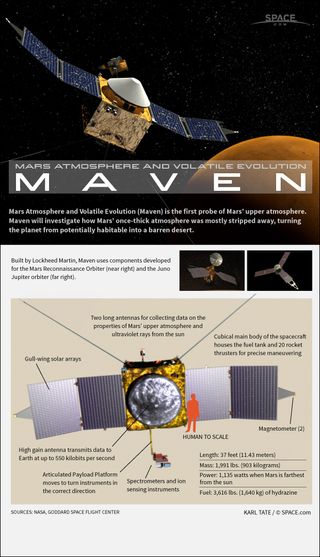NASA's New Mars Orbiter to Study 'Critical Piece' of Martian Puzzle (Video)

NASA's next Mars probe is set to piece together longstanding mysteries about the atmosphere of the Red Planet.
Earlier robotic probes and rovers sent to Mars were designed to investigate the surface of the planet, but the space agency's Mars Atmosphere and Volatile Evolution spacecraft (MAVEN) is built for a different target: the planet's atmosphere.

"The Martian atmosphere is a critical piece of the puzzle of how Mars works," Jim Garvin, chief scientist at NASA's Goddard Space Flight Center in Greenbelt, Md., said. "Certainly Mars was born with a different atmosphere than we think we see today." [NASA's MAVEN Mars Probe: 10 Surprising Facts]
You can watch a video of Garvin discussing MAVEN and other Mars missions on SPACE.com
The MAVEN spacecraft is set to launch atop an Atlas 5 rocket from Cape Canaveral Air Force Station in Florida on Monday (Nov. 18) at 1:28 p.m. EST (1828 GMT). You can watch the launch live on SPACE.com, via NASA TV, beginning at 11 a.m. EST (1400 GMT).
The $671 million MAVEN mission will study Mars' upper atmosphere to help scientists understand how the Red Planet lost its atmosphere over time. Scientists think that ancient Mars had a relatively thick atmosphere, but now it is only about 1 percent as thick as Earth's, scientists have said.
Scientists don't have a lot of information about Mars' atmosphere. "MAVEN is going to fill in a lot of the gaps that we've known we needed to fill in since the 1970s," Garvin said.
Get the Space.com Newsletter
Breaking space news, the latest updates on rocket launches, skywatching events and more!
Today, Mars is cold and dry, but evidence suggests that the world was once rich with liquid water. Because Mars is smaller than Earth, its atmosphere is more tenuous, Garvin told SPACE.com.

By using MAVEN's extensive instrumentation, scientists can combine observations made by rovers on the planet's surface to understand how the atmosphere was lost to space as Mars evolved.
"We need to measure the atmosphere of Mars today, how it works, how it's lost to space, how it interacts with the solar wind, how that relates to the chemistry of the rocks on the surface that we're measuring with Curiosity, that we measured with Spirit and Opportunity," Garvin told SPACE.com. "All that is part of this big ensemble of information we need to really understand how Mars works."
![Since the 1960s, humans have invaded our neighboring planet Mars with swarms of spacecraft. Only about half of the attempts have been successful. See how many robot missions to Mars have launched in this SPACE.com infographic. [See the Full Occupy Mars Infographic]](https://cdn.mos.cms.futurecdn.net/axtSHqkGu8QzSEiswjhZ6d-320-80.jpg)
MAVEN is the 10th orbiter launched to Mars by NASA. Currently, the space agency's Mars Reconnaissance Orbiter, Mars Odyssey and the European Space Agency's Mars Express are active spacecraft in orbit around Mars. The Mars rover Curiosity and Opportunity are both functioning on the surface of the planet.
"Mars is a big place and really, it's a rather tricky place. It has beguiled us ever since we sent our first spacecraft by the planet, and so, as we start to piece together the information to understand this world, a place where we can reasonably ask, 'Could there have been a record of past life?' We need to bring all the information together to pose that question in an informed way."
Find the latest MAVEN news, photos and videos on SPACE.com. You can also follow MAVEN coverage through SPACE.com's partner, Spaceflight Now.
Follow Miriam Kramer @mirikramer and Google+. Follow us @Spacedotcom, Facebookand Google+. Original article on SPACE.com.
Join our Space Forums to keep talking space on the latest missions, night sky and more! And if you have a news tip, correction or comment, let us know at: community@space.com.

Miriam Kramer joined Space.com as a Staff Writer in December 2012. Since then, she has floated in weightlessness on a zero-gravity flight, felt the pull of 4-Gs in a trainer aircraft and watched rockets soar into space from Florida and Virginia. She also served as Space.com's lead space entertainment reporter, and enjoys all aspects of space news, astronomy and commercial spaceflight. Miriam has also presented space stories during live interviews with Fox News and other TV and radio outlets. She originally hails from Knoxville, Tennessee where she and her family would take trips to dark spots on the outskirts of town to watch meteor showers every year. She loves to travel and one day hopes to see the northern lights in person. Miriam is currently a space reporter with Axios, writing the Axios Space newsletter. You can follow Miriam on Twitter.
